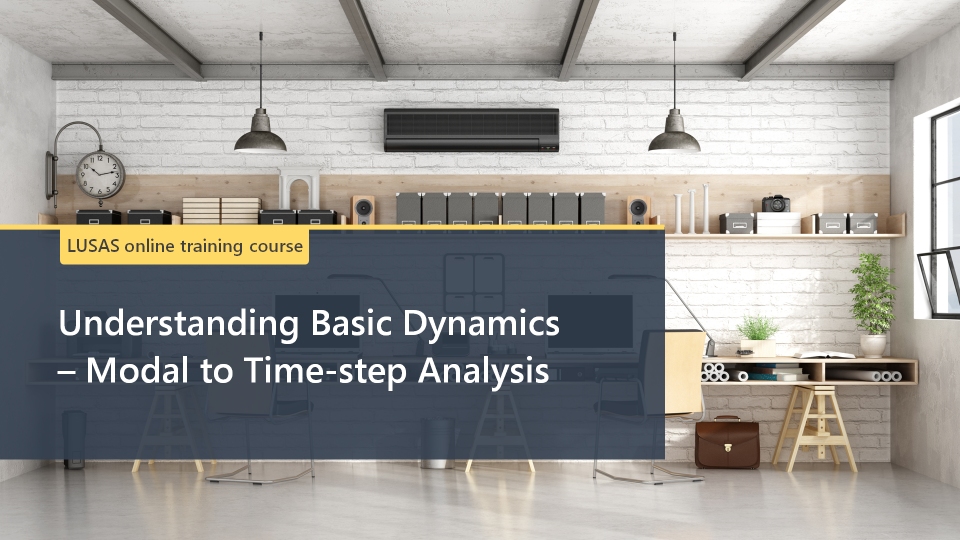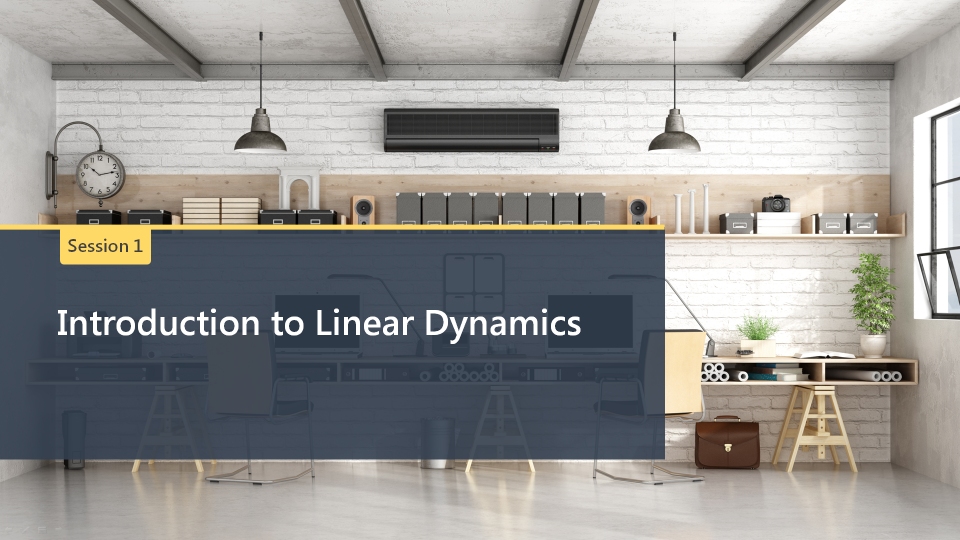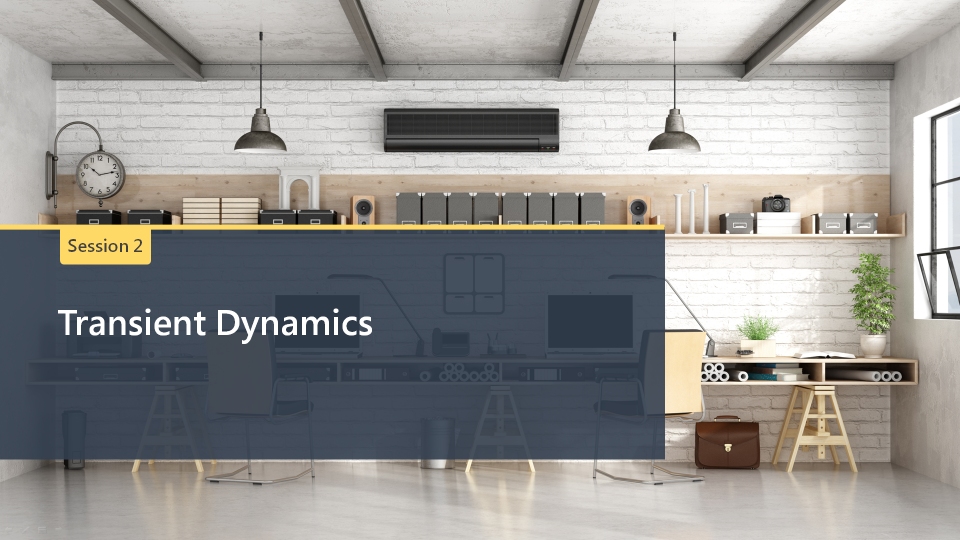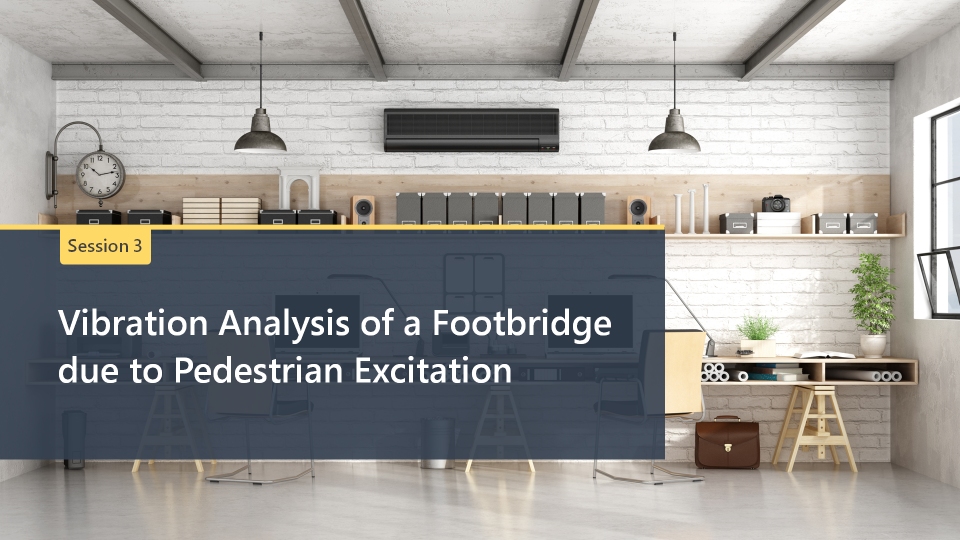Live
Online Training
Course
LUSAS
Training Courses - dates and links to course details
Understanding Basic Dynamics - Modal
to Time-step Analysis
Course Summary
|
Featuring three live online sessions of 90 - 120
minutes each, this course is
for engineers with a good understanding of linear analysis but who
need to progress to dynamic analysis for design and assessment.
Many problems facing designers and engineers are
dynamic in nature, whether it be vibration of a footbridge or impact
of an object hitting a structure. While the assumption of linearity
is routinely used for many designs with the application of dynamic
load factors, sometimes a more refined - dynamic - approach is
justified.
With LUSAS you can straightforwardly model the various forms of
dynamic behaviour that can be encountered, and become proficient in
using tools and facilities that are often seen to be the preserve of
the experts.
|
|

|
|
Obtain answers and practical engineering
guidance to the following:
- Understand why you need to move from linear to dynamic analysis.
- Appreciate the fundamentals of dynamic analysis whether it is a modal vibration problem or a true time step analysis.
- Appreciate why modal analysis can be used to predict vibration modes of your structure (as long as the structure itself behaves in a linear way).
- Consider why nonlinear transient dynamic analysis can deal with boundary conditions, and why structural responses are
nonlinear.
- Get an overview of the major application uses of dynamic analysis, from simple natural frequency calculations to time based seismic analysis and how to set them up in LUSAS
- Learn from practical dynamic examples including
assessment of a footbridge due to footfall induced vibration considering codes of practice.
Potential delegates should ensure
they are familiar with linear static analysis using LUSAS prior to
attending this course.
|
Course Session Dates
| Course
name |
Session
dates |
No
of sessions |
Time
of each session |
Course
cost |
Booking |
Understanding
Basic Dynamics
- Modal to Time-step Analysis |
8,
15, 22 January 2026 |
3 |
14:00
- 16:00 BST |
450
GBP |

|
Bookings and payments
-
To book and pay for a single place on
a course click the 'Book now' button. If multiple bookings of
staff from the same organisation are required with payment to be
made via a single invoice, please
contact the training course administrator at training@lusas.com
-
Course costs include
handouts and are quoted in local
currencies and are exclusive of any local government taxes (if
applicable).
-
Please note that when paying by credit card the
amount charged in your currency may differ according to exchange rates and credit
card fees incurred, which are beyond our control.
-
For cancellations to attend a training course that are received in writing
at least 1 day prior to the first session taking place, the
course cost will be refunded.
-
LUSAS reserves the right
to reject bookings and
to cancel or re-schedule courses or individual sessions in the
unlikely event of this being required.
Online training information
| Sessions
presented using |
Session
length |
After
session offline self-study required |
Training
certificates |
| GoToWebinar |
90 to 120 minutes |
45
to 60 minutes |
Issued
on successful completion |
Notes
-
Training sessions
are provided using the GoToWebinar
web conferencing facility. You can join each training session up to 10 minutes before the scheduled start
time. They will start promptly.
-
Training sessions
are a mix of PowerPoint presentation and live demonstration
of LUSAS.
-
Delegates do
not undertake any hands-on examples during each session, but examples that cover the concepts introduced are provided for download and use by
delegates after each session. These examples will take between 45 and 60
minutes of offline self-study to complete. Email support is available from the
presenter to assist with these examples if needed.
-
Session
presentations can be downloaded from a training course event page
and printed off if required.
-
Delegates
are able to ask the presenter
questions during the training session via the chat tool or afterwards via email.
-
Sessions
are recorded and links to recordings will be provided to
delegates to allow viewing if a session is missed.
-
Training
certificates are provided to those who successfully complete the
series of worked examples and pass the quiz set after each
session.
-
Registration
for Session 1 is a requirement to attend all
subsequent sessions.
On successful completion
of the course, and with subsequent experience, delegates should be
able to successfully tackle many types of dynamic analyses that are
encountered in mainstream structural and bridge engineering.
LUSAS software version
Accessing LUSAS
Please note that the
latest release version of LUSAS will be used for the training
course. Individuals who wish to attend the
training who do not have access to the required version of the
software may request a
temporary training licence from LUSAS to allow the running of the
software on their personal computers. After
booking your place on the course, please
contact training@lusas.com
to request a licence stating your name and details as asked for on
the booking form.
Downloading LUSAS
LUSAS may be downloaded either as an
ISO file, or as a small startup executable. Use whichever is better or works for
you.
| Options
for downloading LUSAS Version 23
|
| ISO file
|
OR |
Web
installer
|
| Download a
single disk image file containing all installation
components.
Select this option for offline installation on one or more
PCs. |
Download a
small setup executable which allows you to choose those
components that you wish to download and install.
Select this option for online installation on a single PC.
|
|

|

|
Please contact training@lusas.com
if you have any questions relating to the licence key sent to you.
Typical Course Content
Session 1 -
Introduction to Linear Dynamics
 Learn
what linear dynamics actually involves with the use of basic examples not
complex theory. The chosen examples give different outcomes in linear and
dynamic approaches. Learn
what linear dynamics actually involves with the use of basic examples not
complex theory. The chosen examples give different outcomes in linear and
dynamic approaches.
-
Overview of linear dynamics (modal analysis) and progression to modal superposition for designers to calculate design effects from dynamics situations to be used to assess/design structures.
-
Discussion on damping and why it is important to understand the damping level used for an analysis and the effect it has.
-
Presentation and homework example:
Linear modelling of a steel frame footbridge including both structural and
non-structural mass to assess basic modal dynamics on the structure.
-
Online quiz to complete the
session.
|
Session 2 - Transient
Dynamics
 Learn
why linear dynamics cannot be used in all cases and which scenarios require the
move to transient dynamics Learn
why linear dynamics cannot be used in all cases and which scenarios require the
move to transient dynamics
-
Overview of transient dynamics
techniques using simple models to explore how to set up a transient dynamic
analysis and explore the results that are obtained.
-
Presentation and homework example: Modifying the steel frame footbridge
model created in session 1 to assess transient dynamics on the structure.
-
Online quiz to complete the session.
|
Session 3 –
Vibration Analysis of a Footbridge due to Pedestrian Excitation
 Understand
the process of assessing a footbridge for pedestrian induced vibration based on
design code requirements. Understand
the process of assessing a footbridge for pedestrian induced vibration based on
design code requirements.
-
Understand the process of
assessing the dynamic behaviour of a footbridge and how to set up the
relevant analysis required.
-
Presentation and homework example: Dynamic
analysis of footbridge by initially assessing if the footbridge is likely to
have dynamic issues and then progressing to calculating the actual response
of the bridge and checking results against design code limits.
-
Online quiz to complete the session.
|
|
Some delegate
feedback from LUSAS scheduled training courses:
-
“This
class was excellent and one of the best training courses that I
have taken." (Tim E.)
-
“Very
good demonstrations/teachers with a good variety of hands-on
examples.” (Douglas R.)
-
"The
instructor was phenomenal! Engaged, energetic, helpful and
friendly! Could not have asked for a better one." (Joe K.)
LUSAS
Training Courses - dates and lInks to course details
Back to Top |